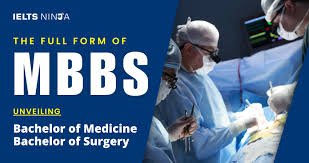
MBBS
When it comes to medical education, few degrees hold as much universal recognition as MBBS, the foundational qualification for becoming a medical doctor in many countries. Despite its global reputation, many people are unaware of what MBBS actually stands for, how the course is structured, and what career paths it opens. The full form of MBBS is Bachelor of Medicine and Bachelor of Surgery, derived from the Latin terms “Medicinae Baccalaureus” and “Baccalaureus Chirurgiae”. Though it is technically two degrees, they are awarded together as a single undergraduate program. The MBBS program is the bedrock of medical training in countries like India, UK, Australia, and others that follow the British system of medical education. This article explores the full form and scope of MBBS, the eligibility criteria, structure of the course, subjects studied, and its global significance in shaping the future of healthcare.
Full Form and Historical Roots
The full form of MBBS is Bachelor of Medicine, Bachelor of Surgery, which may seem confusing because the title includes two degrees. The origin of this lies in the medieval English education system, where medicine and surgery were taught as distinct disciplines. Over time, as medical science evolved and both practices became integrated, universities began awarding both degrees concurrently. MBBS continues to follow this traditional nomenclature even though it’s now a single unified course. In countries that follow the American model, the equivalent degree is the MD (Doctor of Medicine), which is usually a postgraduate program, unlike MBBS which is undergraduate.
Course Duration and Structure
In most countries, the duration of MBBS ranges from five to six years, depending on the curriculum set by the respective medical council or regulatory authority. For example, in India, MBBS takes 5.5 years, which includes 4.5 years of academic study and 1 year of compulsory rotatory internship. The course is typically divided into pre-clinical, para-clinical, and clinical phases. Students first study foundational subjects like Anatomy, Physiology, and Biochemistry. These are followed by more application-based subjects such as Pathology, Pharmacology, and Microbiology. In the clinical phase, students engage in hospital-based training and learn disciplines like General Medicine, Surgery, Pediatrics, Gynecology, Psychiatry, and Ophthalmology. The internship is a critical period where students work under supervision across all major departments to gain hands-on clinical experience.
Eligibility and Admission Process
To pursue an MBBS degree, students must meet specific eligibility criteria set by each country. In India, students must complete 12th grade (10+2) with Physics, Chemistry, and Biology as core subjects and qualify in the NEET (National Eligibility cum Entrance Test). In the UK, applicants take the UCAT or BMAT exams and undergo interviews. In Australia, candidates may require the UMAT or UCAT ANZ and meet ATAR score thresholds. Some countries like the USA do not offer MBBS but require a bachelor’s degree before applying to an MD program. Admission to MBBS is highly competitive due to limited seats, especially in public institutions, making it one of the most difficult programs to enter worldwide.
Subjects and Skills Covered
The MBBS syllabus is extensive and designed to build both theoretical knowledge and clinical skills. Core subjects include Human Anatomy, Medical Physiology, Biochemistry, Pathology, Pharmacology, and Microbiology. During the clinical years, students study Internal Medicine, General Surgery, Obstetrics and Gynecology, Pediatrics, Ophthalmology, ENT, and Community Medicine. Students also learn about medical ethics, patient communication, and evidence-based medicine. Many programs now include simulation-based training and problem-based learning to enhance diagnostic thinking and decision-making.
Importance of MBBS in Healthcare
Doctors form the backbone of any healthcare system, and the MBBS degree is the first step toward becoming a licensed physician. MBBS graduates provide primary care, diagnose diseases, manage emergencies, and offer preventive health services. In rural areas and developing countries, MBBS doctors often serve as the only point of contact for medical aid. The degree is a gateway to specialization, allowing graduates to pursue MD (Doctor of Medicine), MS (Master of Surgery), or other postgraduate diplomas. MBBS also opens doors to research, public health administration, and global health organizations. The rigorous training, long duration, and heavy responsibilities associated with MBBS signify its importance in maintaining public health and medical standards worldwide.
Challenges in Pursuing MBBS
While MBBS is a prestigious qualification, it is also incredibly demanding. Students face long study hours, high stress levels, and intense competition. Mental health issues such as burnout and depression are common among medical students due to academic pressure. Financial challenges also exist, especially in countries where private medical colleges charge high tuition fees. Furthermore, in many regions, the doctor-to-patient ratio remains low, causing overwork and resource constraints. Despite these hurdles, the commitment shown by MBBS students reflects their passion for healing and helping society, which makes the degree one of the most respected in the world.
Conclusion
The MBBS degree, with its full form Bachelor of Medicine, Bachelor of Surgery, is much more than just a qualification—it is a global standard for clinical competence and ethical medical practice. Rooted in centuries of academic tradition and continuously evolving with scientific advancement, MBBS remains the cornerstone of medical education. It demands discipline, compassion, and an unwavering commitment to human welfare. For those who pursue it, MBBS offers the privilege of not just learning medicine but of practicing it with a purpose. Understanding its full form, history, structure, and significance reveals why MBBS is considered one of the most valuable and challenging degrees in the world.






